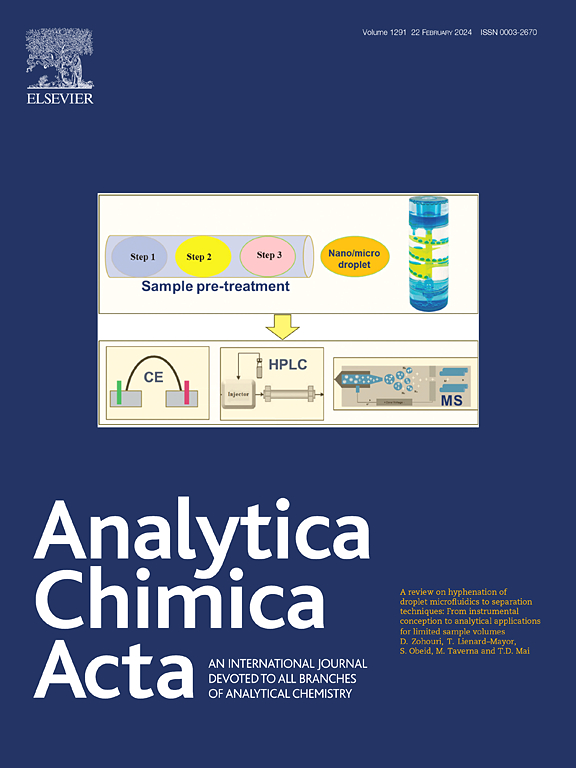Turn-on fluorometric and colorimetric dual-mode assay based on the in situ formation of silicon nanoparticles for the determination of β-galactosidase
IF 5.7
2区 化学
Q1 CHEMISTRY, ANALYTICAL
引用次数: 0
Abstract
Background
β-Galactosidase (β-Gal) is widely acknowledged as a crucial biomarker for primary ovarian cancer. Therefore, precise analysis of β-Gal plays a significant role in the early diagnosis of primary ovarian cancer. In contrast to organic molecule probes, silicon nanoparticles (Si NPs) have garnered significant attention owing to their outstanding photoluminescence stability and good biocompatibility. Nevertheless, most nanomaterials synthesized under stringent conditions generally produce a single signal that is susceptible to various external influences. Thus, there is an urgent need to develop multi-mode sensing techniques based on Si NPs synthesized under mild conditions for the measurement of β-Gal.
Results
In this study, we developed an innovative and straightforward turn-on fluorometric and colorimetric dual-mode sensing method using silicon nanoparticles (Si NPs) for the detection of β-Gal activity. Such Si NPs, exhibiting a brown-red color and yellow fluorescence, can be readily synthesized under mild conditions by mixing 3-(2-aminoethylamino)propyl-dimethoxymethylsilane and p-aminophenol (AP), both of which are non-fluorescent. By substituting AP with 4-aminophenyl-β-d-galactopyranoside, a substrate that can be hydrolyzed to AP by β-Gal, a sensing platform for detecting β-Gal activity can be constructed. The sensing system is capable of detecting β-Gal within the concentration ranges of 0.1–90 U/L for the fluorometric assay and 0.25–50 U/L as well as 50–100 U/L for the colorimetric assay, respectively. The limits of detection were determined to be 0.052 and 0.171 U/L, accordingly.
Significance
This work introduces, for the first time, a straightforward and convenient dual-mode turn-on fluorometric and colorimetric method utilizing novel Si NPs to determine β-Gal activity. The developed sensing assay was effectively utilized to measure β-Gal levels in human serum and to screen for β-Gal inhibitors, demonstrating its practicality and promising potential in the diagnosis of ovarian cancer and pharmaceutical development.

开启基于原位形成的硅纳米颗粒的荧光和比色双模式测定,用于测定β-半乳糖苷酶
β-半乳糖苷酶(β-Gal)被广泛认为是原发性卵巢癌的重要生物标志物。因此,精确分析β-Gal对原发性卵巢癌的早期诊断具有重要意义。与有机分子探针相比,硅纳米颗粒(Si NPs)因其出色的光致发光稳定性和良好的生物相容性而备受关注。然而,大多数在严格条件下合成的纳米材料通常产生单一信号,易受各种外部影响。因此,迫切需要开发基于温和条件下合成的Si纳米粒子的多模传感技术来测量β-Gal。结果在这项研究中,我们开发了一种创新的、直接的利用硅纳米颗粒(Si NPs)开启荧光和比色双模式传感方法来检测β-Gal活性。这种Si NPs具有棕红色和黄色荧光,可以在温和的条件下将3-(2-氨基乙基氨基)丙基-二甲氧基甲基硅烷和对氨基酚(AP)混合,这两种物质都是不荧光的。通过将AP替换为4-氨基苯基-β- d -半乳糖苷(一种可被β-Gal水解为AP的底物),构建检测β-Gal活性的传感平台。该传感系统能够在0.1-90 U/L的荧光测定浓度范围内检测β-Gal,在0.25-50 U/L和50-100 U/L的比色测定浓度范围内检测β-Gal。检出限分别为0.052和0.171 U/L。这项工作首次介绍了一种简单方便的双模式荧光法和比色法,利用新型Si NPs来测定β-Gal活性。该检测方法已被有效地用于测定人血清中β-Gal水平和筛选β-Gal抑制剂,在卵巢癌诊断和药物开发中显示了其实用性和广阔的应用前景。
本文章由计算机程序翻译,如有差异,请以英文原文为准。
求助全文
约1分钟内获得全文
求助全文
来源期刊

Analytica Chimica Acta
化学-分析化学
CiteScore
10.40
自引率
6.50%
发文量
1081
审稿时长
38 days
期刊介绍:
Analytica Chimica Acta has an open access mirror journal Analytica Chimica Acta: X, sharing the same aims and scope, editorial team, submission system and rigorous peer review.
Analytica Chimica Acta provides a forum for the rapid publication of original research, and critical, comprehensive reviews dealing with all aspects of fundamental and applied modern analytical chemistry. The journal welcomes the submission of research papers which report studies concerning the development of new and significant analytical methodologies. In determining the suitability of submitted articles for publication, particular scrutiny will be placed on the degree of novelty and impact of the research and the extent to which it adds to the existing body of knowledge in analytical chemistry.
 求助内容:
求助内容: 应助结果提醒方式:
应助结果提醒方式:


